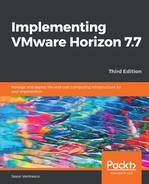There are various Windows settings that cannot be changed using normal Group Policies or other post-installation customizations, such as those we have already described in this chapter. To implement these additional settings, we can customize the default Windows local user profile, implementing changes that will be applied to all users who log into the desktop for the first time.
In most cases, it is possible to create customized scripts or Group Policies that make these changes after a user has already logged into the account. This generally requires changes to the desktop system registry, and an in-depth understanding of how the settings are recorded and updated within Windows.
As we discussed earlier, and this is particularly the case with linked clone and instant clone desktops, it is preferable to apply as much of your customization as you can to the master virtual desktop image. This ensures that the desktops are prepared using the minimum system resources required and are fully configured prior to their use. Policies that apply after the desktops are deployed may require an additional reboot to fully implement, which is not ideal for a Horizon environment. The process used to customize the default local user profile is outlined in the Microsoft Windows IT Pro Center article Create mandatory user profiles (https://docs.microsoft.com/en-us/windows/client-management/mandatory-user-profile). The following settings, each of which helps reduce desktop resource utilization, are recommended to be made to the default local user profile.
